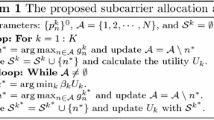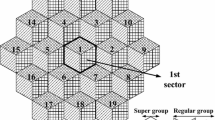Abstract
In this paper, a novel adaptive resource allocation in downlink orthogonal frequency division multiplexing wireless system is investigated. Different from the conventional algorithms, user rate allowed regions are considered. That is, not only the user minimum rate requirements are to be satisfied, but also the maximum rate limitations are introduced to make resource allocation more reasonable. Given equal power distribution, a three-round subcarrier assignment is proposed at first to achieve a preliminary performance. Then, waterfilling-based power allocation is designed to guarantee user rate allowed regions and enhance system performance further. Numerical results show that the proposed algorithm ensures users achieving data rates within their allowed regions more precisely. In the mean time, the system throughput and transmit power consumption are reasonably balanced compared to the traditional methods when channel-gain-to-noise-ratio is high.







Similar content being viewed by others
Notes
Assume that the wireless channel undergoes block fading, i.e., the channel statement does not change during \(T\).
References
Dahlman, E., Parkvall, S., Skold, J., & Beming, P. (2010). 3G evolution: HSPA and LTE for mobile broadband. Amsterdam: Elsevier.
Andrews, J. G., Ghosh, A., & Muhamed, R. (2007). Fundamentals of WiMAX. Englewood Cliffs, NJ: Prentice Hall.
Wong, C. Y., Cheng, R. S., Lataief, K. B., & Murch, R. D. (1999). Multiuser OFDM with adaptive subcarrier, bit, and power allocation. IEEE Journal on Selected Areas in Communications, 17(10), 1747–1758.
Rhee, W., & Cioffi, J. M. (2000). Increase in capacity of multiuser OFDM system using dynamic subchannel allocation. In Proceeding og 2000 IEEE Vehicular Technology Conference - Springer, Vol. 2, pp. 1085–1089.
Yin, H., & Liu, H. (2000). An efficient multiuser loading algorithm for OFDM-based broadband wireless systems. In Proceedings of 2000 IEEE Global Telecommunication, Vol. 1, pp. 103–107.
Jang, J., & Lee, K. B. (2003). Transmit power adaptation for multiuser OFDM systems. IEEE Journal on Areas in Communications, 21(2), 171–178.
Kivanc, D., Li, G., & Liu, H. (2003). Computationally efficient bandwidth allocation and power control for OFDMA. IEEE Transaction on Wireless Communications, 2(6), 1150–1158.
Zhang, Y. J., & Letaief, K. B. (2004). Multiuser adaptive subcarrier-and-bit allocation with adaptive cell selection for OFDM systems. IEEE Transaction on Wireless Communications, 3(5), 1566–1575.
Shen, Z., Andrews, J. G., & Evans, B. L. (2005). Adaptive resource allocation in multiuser OFDM systems with proportional rate constraints. IEEE Transactions on Wireless Communications, 4(6), 2726–2737.
Seong, K., Mohseni, M., & Cioffi, J.M. (2006). Optimal resource allocation for OFDMA downlink systems. In 2006 IEEE International Symposium on Information Theory, pp. 1394–1398
Zhou, C., Wunder, G., & Michel, T. (2007). Utility maximization for ofdma systems over discrete sets. In Proceedings of the 2007 IEEE International Conference on Communication, pp. 5726–5731.
Mao, Z., & Wang, X. (2008). Efficient optimal and suboptimal radio resource allocation in OFDMA system. IEEE Transactions on Wireless Communications, 7(2), 440–445.
Lin, Y.-B., Chiu, T.-H., & Su, Y. (2009). Optimal and near-optimal resource allocation algorithms for OFDMA networks. IEEE Transactions on Wireless Communications, 8(8), 4066–4077.
Nering, E. D., & Tucker, A. W. (1993). Linear programs and related problems. San Diego: Academic Press.
Xiong, C., Li, G. Y., Zhang, S., Chen, Y., & Xu, S. (2012). Energy-efficient resource allocation in OFDMA networks. IEEE Transactions on Communication, 60(12), 3767–3778.
Xiong, C., Li, G. Y., Zhang, S., Chen, Y., & Xu, S. (2011). Energy-and spectral-efficiency tradeoff in downlink OFDMA networks. IEEE Transactions on Wireless Communications, 10(11), 3874–3886.
Fei, Z. S., Xing, C. W., Li, N., Han, Y. T., Danev, D., & Kuang, J. M. (2013). Power allocation for OFDM-based cognitive heterogeneous networks. Science China Information Sciences, 56(4), 1–10.
Zhang, Y., & Leung, C. (2009). Resource allocation in an OFDM-based cognitive radio system. IEEE Transactions on Communications, 57(7), 1928–1931.
Xiong, K., Fan, P., Letaief, K.B., Yi, S., & Lei, M. (2012). Joint subcarrier-pairing and resource allocation for two-way multi-relay OFDM networks. In Proceedings of 2012 IEEE Global Telecommunication, pp. 4874–4879.
Li, G., & Liu, H. (2005). On the optimality of the OFDMA network. IEEE Communications Letters, 9(5), 438–440.
Boyd, S. P., & Vandenberghe, L. (2004). Convex optimization. Cambridge: Cambridge Uuniversity Press.
Acknowledgments
This work was supported by National High-Technology Program (863) of China (No. 2014AA01A701), the Major National science and Technology Special Project (No. 2013ZX03001025-001) and China Next Generation Internet (CNGI) Project (No. CNGI-12-03-003).
Author information
Authors and Affiliations
Corresponding author
Appendix: Proof that the Three-Round Power Allocation is Optimal
Appendix: Proof that the Three-Round Power Allocation is Optimal
Proof
The original power allocation problem under the given subcarrier assignment is a standard convex optimization which can be expressed as
for which the Karush–Kuhn–Tucker (KKT) conditions that are both sufficiently and necessarily optimal can be derived as
Obviously, (14) and (15) are satisfied through the three-round power allocation. Hence, we need to find proper \(\lambda \), \(\alpha _{k}\), and \(\beta _{k}\) to prove that (11)–(13) are hold.
For simplicity, we term \(\lambda -\alpha _{k}+\beta _{k}\) in (11) the “water level coefficient” for user \(k\). In the first round, the water level coefficient corresponding to user \(k\) is \(\eta _{k}\), as expressed in (5). In the second round, we can split users into two groups, of which one is the set of users that obtain power, denoted by \(\fancyscript{G}_{1}\), and the other is the set of users that maintain their minimum levels, denoted by \(\fancyscript{G}_{2}\). For \(k\in \fancyscript{G}_{1}\) there is \(\frac{1}{\theta \mathrm {ln}2}-\frac{1}{g_{k,n}}-\check{p}_{n,k}>0\) according to (7), and for \(k\in \fancyscript{G}_{2}\) we have \(\frac{1}{\theta \mathrm {ln}2}-\frac{1}{g_{k,n}}-\check{p}_{n,k}\le 0\). Hence, for \(k\in \fancyscript{G}_{1}\) we can get \(p_{n,k}=\frac{1}{\theta \mathrm {ln}2}-\frac{1}{g_{k,n}}\), which indicates the water level coefficient changes to \(\theta \).
In the third round, we split the users into three groups: \(\fancyscript{G}_{1}\) for the users that still maintain the minimum power levels, \(\fancyscript{G}_{2}\) for the users of power level between the minimum and maximum, and \(\fancyscript{G}_{3}\) for the users whose power are lowered as a result of the limitation. For \(k\in \fancyscript{G}_{2}\) there is \(\frac{1}{\lambda \mathrm {ln}2}-\frac{1}{g_{k,n}}-\check{p}_{n,k}-\varDelta p_{n,k}^{1}>0\) according to (9); hence, we can have \(p_{n,k}=\frac{1}{\lambda \mathrm {ln}2}-\frac{1}{g_{k,n}}\), which indicates that the water level coefficient changes to \(\lambda \). Since power level of user \(k\in \fancyscript{G}_{1}\) still unchanges, it means that the gradient of user rate respect to power in group \(\fancyscript{G}_{1}\) is no more than that in group \(\fancyscript{G}_{2}\), that is
Hence, it can be derived that \(\lambda \le \eta _{k}\). On the other hand, since power level of user \(k\in \fancyscript{G}_{2}\) is increased comparing to the second round, we can have \(\theta <\lambda \). Likely, the power level of user \(k\in \fancyscript{G}_{3}\) is lowered comparing to the second round, therefore we can also have \(\theta >\gamma _{k}\), where \(\gamma _{k}\) denotes the corresponding water level coefficient for \(k\in \fancyscript{G}_{3}\).
Based on above analysis, there is
Hence, \(\alpha _{k}\) and \(\beta _{k}\) can be found as \(\alpha _{k}=\eta _{k}-\lambda ,\) \(\beta _{k}=0\) for \(k\in \fancyscript{G}_{3}\), \(\alpha _{k}=0\), \(\beta _{k}=\lambda -\gamma _{k}\) for \(k\in \fancyscript{G}_{1}\), and \(\alpha _{k}=\beta _{k}=0\) for \(k\in \fancyscript{G}_{2}\). It is readily indicated that Eqs. (11)–(13) are hold, which show the optimality of the proposed power allocation. \(\square \)
Rights and permissions
About this article
Cite this article
Chen, S., Ren, Z., Hu, B. et al. Resource Allocation in Downlink OFDM Wireless Systems with User Rate Allowed Regions. Wireless Pers Commun 80, 429–445 (2015). https://doi.org/10.1007/s11277-014-2019-1
Published:
Issue Date:
DOI: https://doi.org/10.1007/s11277-014-2019-1




